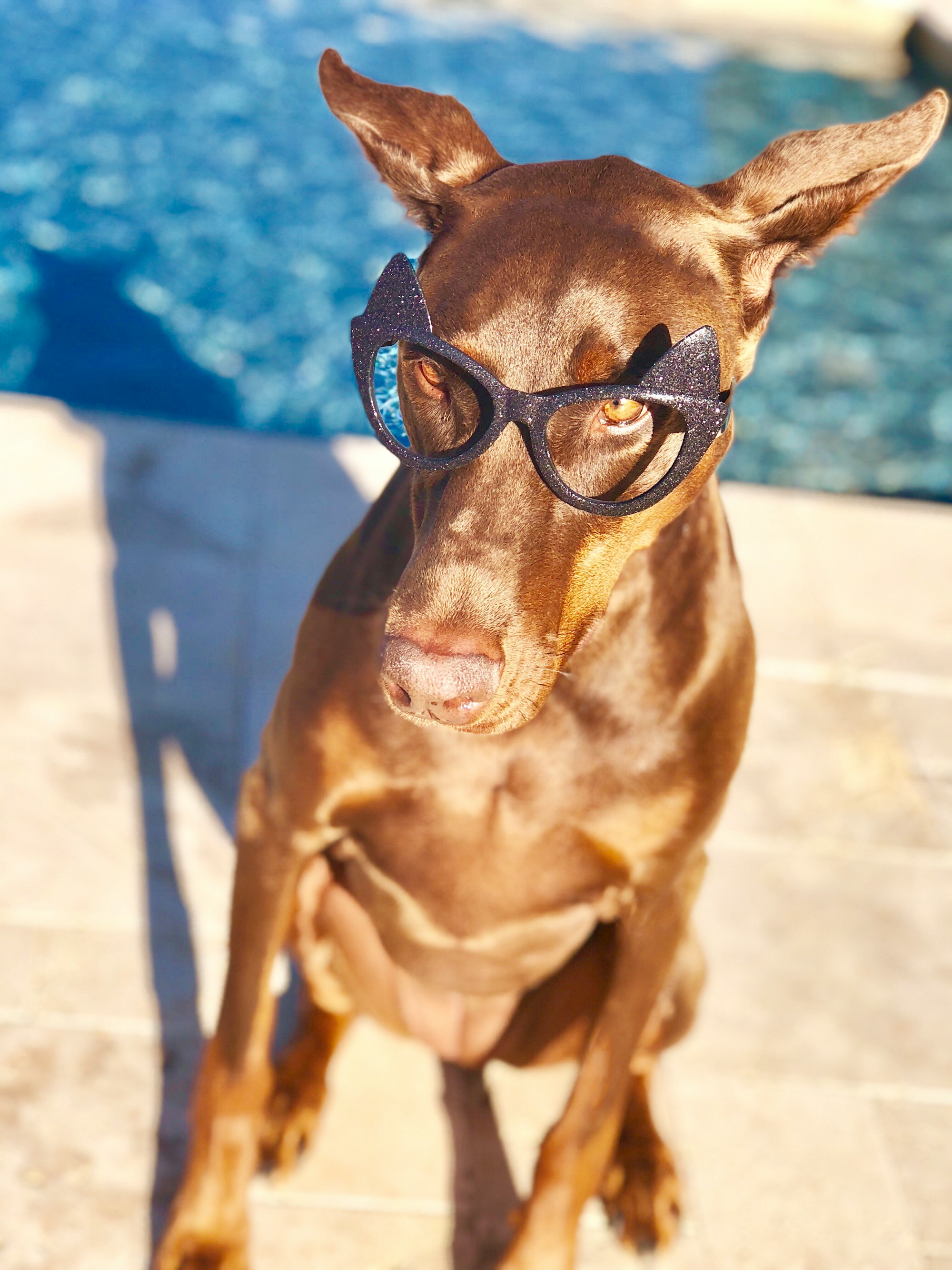Doberman ear cropping is a controversial topic that has sparked discussions among dog owners and enthusiasts. In this article, we will explore the practice of ear cropping in Doberman Pinschers, its historical background, reasons for cropping, the procedure itself, aftercare, and the ethical considerations surrounding it. Whether you are a Doberman owner considering ear cropping or simply interested in the subject, this article aims to provide you with valuable insights and a comprehensive understanding of this practice.

Historical Background of Doberman Ear Cropping
The practice of ear cropping in Doberman Pinschers has a historical background that dates back to the breed's origins in the late 19th century. Dobermans were initially bred by a German tax collector named Louis Dobermann, who desired a loyal and protective working dog to accompany him during his rounds.
During that time, dog fights were prevalent, and Dobermans were used to guard their owners and protect them from harm. To minimize the risk of ear injuries in confrontations with other dogs or potential attackers, ear cropping became a common practice.
The procedure involved surgically removing a portion of the dog's ears and shaping them to stand upright. This alteration was believed to reduce the vulnerability of the ears to damage and make them less prone to infections or hematomas.
Reasons for Ear Cropping
Ear cropping in Doberman Pinschers has been a subject of controversy, with passionate arguments on both sides. Proponents of ear cropping often cite aesthetic reasons as their primary motivation. Here are some of the aesthetic reasons commonly associated with ear cropping:
1. Breed Standard: Many kennel clubs and breed standards specify that Dobermans should have cropped ears. Adhering to these standards is necessary for breeders, show dog enthusiasts and those who wish to maintain the breed's traditional appearance.
2. Distinctive Look: Ear cropping is believed to enhance the Doberman's appearance, giving them a more alert and intimidating expression. The upright ears contribute to the breed's unique and noble presence, distinguishing them from other dog breeds.
3. Symmetry: Cropped ears can help achieve a sense of symmetry and balance in the Doberman's overall appearance. Shaping the ears to stand upright, it creates a harmonious and aesthetically pleasing look.
4. Historical Tradition: Ear cropping has been a long-standing tradition in Doberman history. It is deeply rooted in the breed's origins and the roles they played as guard dogs and companions. Some individuals choose to continue the tradition to honor the breed's heritage.
5. Personal Preference: Some owners simply prefer the look of Dobermans with cropped ears. They find it visually appealing and believe it adds to the dog's allure and presence.
It is essential to acknowledge that these aesthetic reasons are subjective and vary among individuals. While some people value the appearance achieved through ear cropping, others argue for accepting the natural ears of Dobermans. Ultimately, the decision to crop a Doberman's ears should be made after careful consideration of various factors, including ethical concerns, animal welfare, and evolving perspectives on the practice.

The Ear Cropping Procedure
The ear cropping procedure is a surgical intervention performed by a licensed veterinarian. It involves altering the shape and length of a Doberman Pinscher's ears to achieve an upright appearance. Here are the general steps involved in the ear-cropping procedure:
1. Pre-surgical Evaluation: Before proceeding with the surgery, easing fear at the vet will conduct a thorough evaluation of the dog's health. This evaluation includes a physical examination, blood tests, and possibly X-rays to ensure the dog is fit for the procedure.
2. Anesthesia and Surgery: Once the dog is deemed suitable for surgery, they will be placed under general anesthesia. This ensures that they are comfortable and pain-free during the procedure. The veterinarian will then begin the surgical process.
· Incision: The veterinarian will make incisions along the edges of the dog's ears, typically starting from the base and extending towards the tip.
· Removal of Tissue: Excess tissue is carefully removed from the ear flaps to achieve the desired length and shape. The veterinarian may also trim the edges to create a neat and symmetrical appearance.
· Suturing: After the necessary adjustments are made, the veterinarian will close the incisions using sutures. This helps secure the shape of the ears and allows for proper healing.
3. Post-operative Care: After the surgery, the dog will need appropriate post-operative care to promote healing and minimize discomfort. This may include:
· Pain Management: The veterinarian will prescribe pain medication to alleviate any post-operative pain and ensure the dog's comfort.
· Antibiotics: To prevent infections, the dog may be prescribed antibiotics to be administered during the recovery period.
· Bandaging: The ears may be wrapped in bandages or protective material to provide support and protect the surgical site.
· Follow-up Visits: Regular follow-up visits with the veterinarian are essential to monitor the healing progress and address any concerns that may arise.
It is crucial to note that ear cropping is a surgical procedure and, like any surgery, carries inherent risks. Potential complications can include infection, bleeding, delayed healing, and adverse reactions to anesthesia. Therefore, it is significant to choose a skilled and experienced veterinarian, how often vet and follow their instructions carefully to ensure the best possible outcome for the dog's health and well-being.
Ethical Considerations and Controversies
Doberman ear cropping has been a subject of ethical debates and controversies. The practice raises various concerns regarding animal welfare, unnecessary surgical procedures, and the impact on the dog's quality of life. Here are some of the key ethical considerations and controversies surrounding Doberman ear cropping:
1. Pain and Discomfort: Ear cropping is a surgical procedure that involves cutting and reshaping the dog's ears. Opponents argue that subjecting dogs to this procedure causes unnecessary pain and discomfort, as it is primarily performed for cosmetic reasons rather than medical necessity.
2. Informed Consent: Dogs cannot provide informed consent for surgical procedures. Ear cropping is an elective surgery that is often carried out without the direct consent of the dog, raising questions about the ethical implications of performing such procedures without clear medical benefits.
3. Aesthetic Preference vs. Animal Welfare: The decision to crop a Doberman's ears is often driven by aesthetic preference, conforming to breed standards or personal taste. Critics argue that prioritizing appearance over the well-being and natural state of the dog is ethically questionable.
4. Potential Surgical Complications: Like any surgical procedure, ear cropping carries risks of complications, including infection, bleeding, poor wound healing, and adverse reactions to anesthesia. These risks raise concerns about subjecting dogs to unnecessary surgical procedures that may compromise their health.
5. Shifting Perspectives and Evolving Standards: Over time, societal attitudes and perspectives on ear cropping have shifted. Many countries and regions have implemented regulations and bans on the practice, recognizing the ethical concerns associated with elective cosmetic surgeries on animals.
6. Breeding Responsibility: Breeders play a crucial role in perpetuating or discouraging ear cropping. Ethical breeders prioritize the overall health and well-being of the good family dogs they breed, considering the potential risks and ethical implications of ear cropping.

It is decisive to note that the ethical considerations surrounding ear cropping are complex and subjective. Different stakeholders may hold differing opinions on the matter. As societal attitudes and regulations change, individuals must engage in informed discussions, consider the welfare of the dog, and weigh the ethical implications before making decisions regarding ear cropping.
As the controversy surrounding Doberman ear cropping persists, alternative options have emerged for those who prefer not to crop their dogs' ears. These alternatives aim to achieve a similar aesthetic appearance while avoiding surgical interventions. Here are some alternatives to consider:
1. Conformation Techniques: Conformation techniques involve shaping and training the natural ears of Dobermans to stand upright. This process typically includes methods such as taping, bracing, and using supportive devices to encourage the ears to develop the desired upright position. While this approach requires time, patience, and consistency, it can be a viable alternative for those who desire the appearance of cropped ears without surgery.
2. Accepting Natural Ears: An increasing number of Doberman enthusiasts and owners are embracing the natural ear look. They believe that the dog's intelligence, loyalty, and working abilities are not dependent on the shape of their ears. By accepting and appreciating the natural ears, owners can celebrate the breed's unique characteristics without resorting to surgical alterations.
3. Breed Selection: When considering getting a Doberman, individuals have the option to choose a bloodline that naturally exhibits the desired upright ear appearance. By selecting dogs with naturally erect ears, there is no need for surgical interventions to achieve the desired aesthetic.
4. Education and Awareness: Promoting awareness about the natural appearance of Doberman ears and educating breeders, owners, and enthusiasts about the potential alternatives to cropping can help shift attitudes and reduce the demand for this practice. Encouraging discussions about the benefits of embracing the natural appearance can contribute to a more compassionate and responsible approach to Doberman ownership.
It is essential to note that the decision to opt for alternatives to ear cropping should be made based on personal values, preferences, and consideration for the well-being of the dog. Responsible breeders, owners, and the dog community as a whole should prioritize the health, comfort, and natural state of Dobermans while appreciating their unique qualities, regardless of the ear shape.
Legal Regulations and Bans
In response to the ethical concerns and controversies surrounding Doberman ear cropping, some countries and regions have implemented legal regulations and bans on the practice. These regulations aim to protect animal welfare and discourage unnecessary surgical procedures performed solely for cosmetic purposes. The specific regulations and legal stance on ear cropping vary from place to place. Here are some examples:
1. United States: In the United States, the regulations regarding ear cropping vary at the state level. Some states allow ear cropping as long as it is performed by a licensed veterinarian, while other states have banned the practice unless it is for therapeutic or medical reasons.
2. European Union: Ear cropping is prohibited in most European countries. The European Convention for the Protection of Pet Animals, which has been ratified by many European nations, explicitly prohibits the cropping of ears and docking of tails for non-medical reasons.
3. Australia: Ear cropping is generally banned throughout Australia. The country has strict regulations regarding cosmetic procedures on animals, including ear cropping, considering them to be unnecessary and potentially harmful.
4. Canada: In Canada, ear cropping is considered a controversial practice. Some provinces have restrictions or guidelines in place, while others leave the decision up to the discretion of veterinarians and owners.
Owners and breeders need to familiarize themselves with the legal regulations specific to their country or region to ensure compliance with the law and to prioritize the well-being of their dogs.
Opinions and Stances
Opinions on Doberman ear cropping vary among different stakeholders, including veterinarians, breeders, show dog enthusiasts, and animal welfare organizations. Here are some common stances associated with ear cropping:

1. Veterinarians: Veterinarians' opinions on ear cropping are diverse. While some veterinarians still perform the procedure, many others refuse to offer it, considering it unnecessary and potentially detrimental to the dog's welfare. Veterinarians who oppose ear cropping advocate for alternatives and emphasize the importance of considering the dog's overall health and well-being.
2. Breeders and Show Dog Enthusiasts: Breeders and show dog enthusiasts often have differing opinions on ear cropping. Some continue the tradition of ear cropping, believing it is essential for preserving the breed's aesthetics and maintaining competitive standards in dog shows. Others have shifted their practices to embrace natural ears and focus on other aspects of the breed, recognizing the evolving perspectives on the matter.
3. Animal Welfare Organizations: Animal welfare organizations generally oppose ear cropping and advocate against it. They argue that unnecessary surgical alterations for cosmetic purposes should be avoided and that the welfare of the dog should always be the primary concern. These organizations often promote responsible ownership, education, and alternatives to ear cropping.
Opinions on ear cropping continue to evolve, and discussions surrounding the practice are ongoing. Individuals need to engage in respectful conversations, consider the welfare of the dogs, and stay informed about the latest perspectives and advancements in understanding the ethical implications of ear cropping.

FAQs (Frequently Asked Questions)
1. Is ear cropping painful for Doberman Pinschers?
Ear cropping is performed under general anesthesia, ensuring that the dog does not experience pain during the procedure. However, discomfort and post-operative pain may occur during the healing process.
2. Can Doberman ears stand up naturally without cropping?
Yes, some Doberman ears can stand up naturally without cropping. However, it is more common for the breed to have floppy ears if left natural.
3. How long does it take for Doberman ears to heal after cropping?
The healing process can take several weeks to several months, depending on the individual dog and the effectiveness of post-operative care.
4. Are there alternative methods to enhance the appearance of Doberman ears?
Yes, there are alternative methods such as ear taping, which can be used to encourage natural ear positioning and standing.
5. Are there countries where Doberman ear cropping is prohibited?
Yes, some countries, including several in Europe, have banned ear cropping and consider it illegal under animal welfare regulations.
Continue reading about Doberman lifespan, collars, and shedding in brief.
Conclusion
Doberman ear cropping is a practice deeply rooted in the breed's history, with proponents emphasizing its aesthetic appeal and potential health benefits. However, ethical concerns and evolving societal perspectives have led to increased scrutiny and discussions on whether ear cropping should continue. As a responsible happy dog owner, it is crucial to thoroughly research and consider all aspects before making a decision regarding ear cropping for your Doberman Pinscher.




